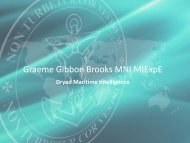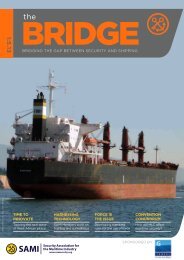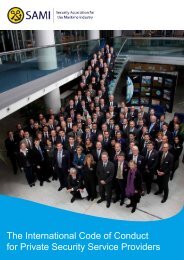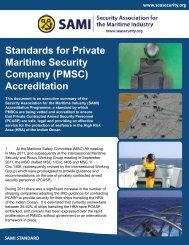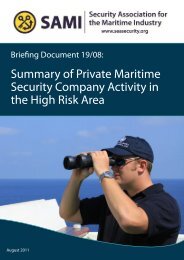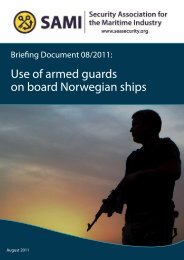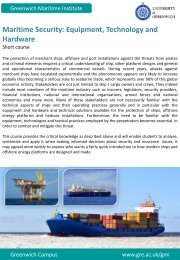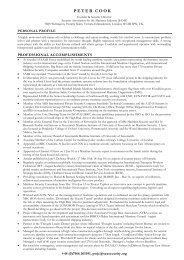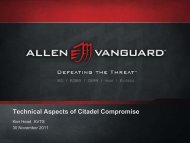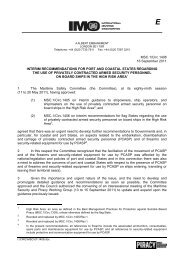C5.2.f. Is there guidance or a model for a port State inspection <strong>and</strong> monitoring system <strong>and</strong> toprovide guidance to authorized officers?The tripartite experts’ meeting in September 2008 adopted the Guidelines for portState control officers carrying out inspections under the <strong>Maritime</strong> <strong>Labour</strong><strong>Convention</strong>, 2006 37 to assist port State control officers to carry out inspections of foreignships coming into their ports [see A14. What is the status of the 2008 ILO Guidelines, forflag State inspections <strong>and</strong> port State control officers?]. The need to develop internationalguidelines <strong>and</strong> related national guidance for port State control officers had, in fact, beenforeseen in the MLC, 2006 itself. The MLC, 2006 begins, in Article I, by requiring that:“Members shall cooperate with each other for the purpose of ensuring the effectiveimplementation <strong>and</strong> enforcement of the <strong>Convention</strong>.” More specifically Regulation 5.2.1,paragraph 3 provides that “Inspections in a port shall be carried out by authorized officersin accordance with the provisions of the Code <strong>and</strong> other applicable internationalarrangements governing port State control inspections in the Member”. St<strong>and</strong>ard A5.2.1,paragraph 7 provides that “Each Member shall ensure that its authorized officers are givenguidance, of the kind indicated in Part B of the Code, as to the kinds of circumstancesjustifying detention of a ship under paragraph 6 of this St<strong>and</strong>ard”. Finally, GuidelineB.5.2.1, paragraph 3 provides that “Members should cooperate with each other to themaximum extent possible in the adoption of internationally agreed guidelines on inspectionpolicies, especially those relating to the circumstances warranting the detention of a ship”.Developing guidelines for port State control officers was an important response to the callfor “internationally agreed guidelines”, in so far as the implementation of the MLC, 2006is concerned. However, a harmonized approach to port State control is an ongoing processthat includes cooperation among countries <strong>and</strong> coordination of maritime inspection underseveral maritime <strong>Convention</strong>s, not just the MLC, 2006 but also, particularly, the relevantIMO <strong>Convention</strong>s.C5.2.g. What is to be inspected during port State control?The purpose of the inspection by PSCOs is to determine whether a ship is incompliance with the requirements of the <strong>Convention</strong> (including seafarers’ rights)(Article IV, paragraph 5). These requirements are laid down in the Articles <strong>and</strong>Regulations <strong>and</strong> in Part A (St<strong>and</strong>ards) of the Code of the MLC, 2006, relating to theworking <strong>and</strong> living conditions of seafarers on the ship (Regulation 5.2.1, paragraphs 1<strong>and</strong> 3). Part B (guidelines) of the MLC, 2006, Code is not subject to inspection by portState control. Port State control inspections are, in principle, concerned with the 14 areasof working <strong>and</strong> living conditions on the ship (St<strong>and</strong>ard A5.2.1, paragraph 2) that are listedin Title 5, Appendix A5-III of the MLC, 2006, <strong>and</strong> are to be certified by flag States asbeing in compliance with the related requirements of the <strong>Convention</strong>. However, the PSCOmay also take action in the case of non-compliance with any other requirement of the<strong>Convention</strong> relating to working <strong>and</strong> living conditions (Regulation 5.2.1, paragraph 1).The details for the implementation of the MLC, 2006 requirements are to beprescribed, in accordance with the <strong>Convention</strong>, in the national laws or regulations,collective agreements or other measures in the flag State concerned. On ships carrying amaritime labour certificate, a summary of the relevant national st<strong>and</strong>ards adopted toimplement the MLC, 2006, in the 14 areas referred to will be set out in Part I of the DMLCattached to the certificate. These 14 areas of flag State certification (listed in Appendix A5-I to the MLC, 2006) are the same as the 14 areas that are in principle to be covered by aport State control inspection (listed in Appendix A5-III). As indicated below, thebe useful for port State authorities to consider (Regulation A5.1.4, paragraphs 2, 3, 6, 7, 10, 11<strong>and</strong> 12).37 See footnote 5.FAQ 49
certificate <strong>and</strong> DMLC should be the starting point in the inspection process as theyconstitute prima facie evidence that the ship is in compliance with the requirements of theMLC, 2006 (including seafarers’ rights).PSCOs may also be entrusted with h<strong>and</strong>ling <strong>and</strong> investigating complaints made byseafarers on ships visiting their ports. If complaint h<strong>and</strong>ling is not part of their functions,they should be able to direct seafarers to the competent official for h<strong>and</strong>ling complaints orto receive complaints for transmittal to the competent official.C5.2.h. If a ship’s maritime labour certificate <strong>and</strong> declaration of maritime labour complianceappear to be in order can there be any further inspection?In accordance with Regulation 5.2.1, paragraph 2 <strong>and</strong> St<strong>and</strong>ard A5.2.1, paragraph 1of the MLC, 2006, the maritime labour certificate <strong>and</strong> the declaration of maritime labourcompliance must be accepted as prima facie evidence of compliance with the requirementsof the <strong>Convention</strong>. Accordingly, the inspection in ports must be limited to a review of thecertificate <strong>and</strong> declaration except in the following four cases:(a) the required documents are not produced or maintained or are falsely maintained orthe documents produced do not contain the information required by the <strong>Convention</strong> orare otherwise invalid; or(b) there are clear grounds for believing that the working <strong>and</strong> living conditions on theship do not conform to the requirements of the <strong>Convention</strong>; or(c) there are reasonable grounds to believe that the ship has changed flag for the purposeof avoiding compliance with the <strong>Convention</strong>; or(d) there is a complaint alleging that specific working <strong>and</strong> living conditions on the shipdo not conform to the requirements of this <strong>Convention</strong>.In any of those cases a more detailed inspection may be carried out to ascertain theworking <strong>and</strong> living conditions on board the ship. Such inspection must in any case becarried out where the working <strong>and</strong> living conditions believed or alleged to be defectivecould constitute a clear hazard to the safety, health or security of seafarers or where theauthorized officer has grounds to believe that any deficiencies constitute a serious breachof the requirements of this <strong>Convention</strong> (including seafarers’ rights).C5.2.i. When may the foreign ships of non-ratifying countries be inspected in a port State?Since countries that have not ratified the MLC, 2006 cannot, by definition, produce amaritime labour certificate <strong>and</strong> declaration of maritime labour compliance issued under the<strong>Convention</strong>, they can always be the subject of a port State control inspection, especially inthe light of the obligation on ratifying countries to ensure no more favourable treatment toships of non-ratifying countries [see A4. What is meant by the “no more favorabletreatment” clause?].C5.2.j. What if there is a complaint about a matter that is not on the list of 14 areas to becertified?St<strong>and</strong>ard 5.2.1, paragraph 1 authorizes a more detailed inspection to be carried out ifthere is a complaint alleging that specific working <strong>and</strong> living conditions on the ship “do notconform to the requirements of this <strong>Convention</strong>”. An inspection may therefore be carriedout where the alleged non-conformity relates to any requirement of the MLC, 2006, <strong>and</strong>thus not necessarily a requirement coming within the 14 areas of certification <strong>and</strong> portState control.50 FAQ
- Page 8: C5.1. Flag State responsibilities .
- Page 11 and 12: the Convention regarding the need f
- Page 13 and 14: oard ships but are not directly inv
- Page 15 and 16: supervisory system (a system establ
- Page 18 and 19: A16. How does the MLC, 2006 make it
- Page 20 and 21: A19. What will happen to the mariti
- Page 22 and 23: B. Questions about the workers andt
- Page 27 and 28: authority?] as qualified to issue s
- Page 29 and 30: C1.3.b. Does this training requirem
- Page 31 and 32: It may be useful to also consider t
- Page 33 and 34: equirements for upgrading or promot
- Page 35 and 36: C2.3.h. Do the hour of rest and hou
- Page 37 and 38: C3. Title 3 Accommodation, recreati
- Page 39 and 40: y berths and lockers, chests of dra
- Page 41 and 42: C4.1.b. Must every ship have a ship
- Page 43 and 44: • the cost of safeguarding the pr
- Page 45 and 46: (b) facilities for sports and outdo
- Page 47 and 48: • Sickness benefit• Unemploymen
- Page 49 and 50: agreed upon international standards
- Page 51 and 52: provisions of Regulation 5.1.3 and
- Page 53 and 54: C5.1.o. What is the period of valid
- Page 55 and 56: (b)(c)to carry out any examination,
- Page 57: prevents ships being delayed by unn
- Page 61 and 62: C5.2.q. Are complaints confidential
- Page 64 and 65: INTERNATIONAL LABOUR CONFERENCECont
- Page 66 and 67: Maritime Labour Convention, 2006MAR
- Page 68 and 69: Maritime Labour Convention, 2006(b)
- Page 70 and 71: Maritime Labour Convention, 20062.
- Page 72 and 73: Maritime Labour Convention, 2006Pla
- Page 74: Maritime Labour Convention, 20062.
- Page 78: Explanatory note to the Regulations
- Page 82 and 83: Minimum requirements for seafarers
- Page 84 and 85: Minimum requirements for seafarers
- Page 86 and 87: Minimum requirements for seafarers
- Page 88 and 89: Minimum requirements for seafarers
- Page 90 and 91: Conditions of employmentTITLE 2. CO
- Page 92 and 93: Conditions of employmentGuideline B
- Page 94 and 95: Conditions of employment3. National
- Page 96 and 97: Conditions of employment(a) hours o
- Page 98 and 99: Conditions of employment4. Paragrap
- Page 100 and 101: Conditions of employmentRegulation
- Page 102 and 103: Conditions of employment(b) accommo
- Page 104 and 105: Conditions of employmentciently and
- Page 106 and 107: Accommodation, recreational facilit
- Page 108 and 109:
Accommodation, recreational facilit
- Page 110 and 111:
Accommodation, recreational facilit
- Page 112 and 113:
Accommodation, recreational facilit
- Page 114 and 115:
Accommodation, recreational facilit
- Page 116 and 117:
Accommodation, recreational facilit
- Page 118 and 119:
Accommodation, recreational facilit
- Page 120 and 121:
Health protection, medical care, we
- Page 122 and 123:
Health protection, medical care, we
- Page 124 and 125:
Health protection, medical care, we
- Page 126 and 127:
Health protection, medical care, we
- Page 128 and 129:
Health protection, medical care, we
- Page 130 and 131:
Health protection, medical care, we
- Page 132 and 133:
Health protection, medical care, we
- Page 134 and 135:
Health protection, medical care, we
- Page 136 and 137:
Health protection, medical care, we
- Page 138 and 139:
TITLE 5. COMPLIANCE AND ENFORCEMENT
- Page 140 and 141:
Compliance and enforcement(a) has t
- Page 142 and 143:
Compliance and enforcement7. Detail
- Page 144 and 145:
Compliance and enforcement14. A cer
- Page 146 and 147:
Compliance and enforcement5. If a M
- Page 148 and 149:
Compliance and enforcement(a) the i
- Page 150 and 151:
Compliance and enforcementGuideline
- Page 152 and 153:
Compliance and enforcement(c)(d)the
- Page 154 and 155:
Compliance and enforcementStandard
- Page 156 and 157:
APPENDIX A5-IThe working and living
- Page 158 and 159:
Appendix A5-IIThis is to certify:1.
- Page 160 and 161:
Appendix A5-IIMaritime Labour Conve
- Page 162 and 163:
Appendix A5-IISignature: ..........
- Page 166 and 167:
Appendix A5-IIThis Certificate is v
- Page 168 and 169:
APPENDIX B5-I - EXAMPLE OF A NATION
- Page 170:
Appendix B5-IDeclaration of Maritim




